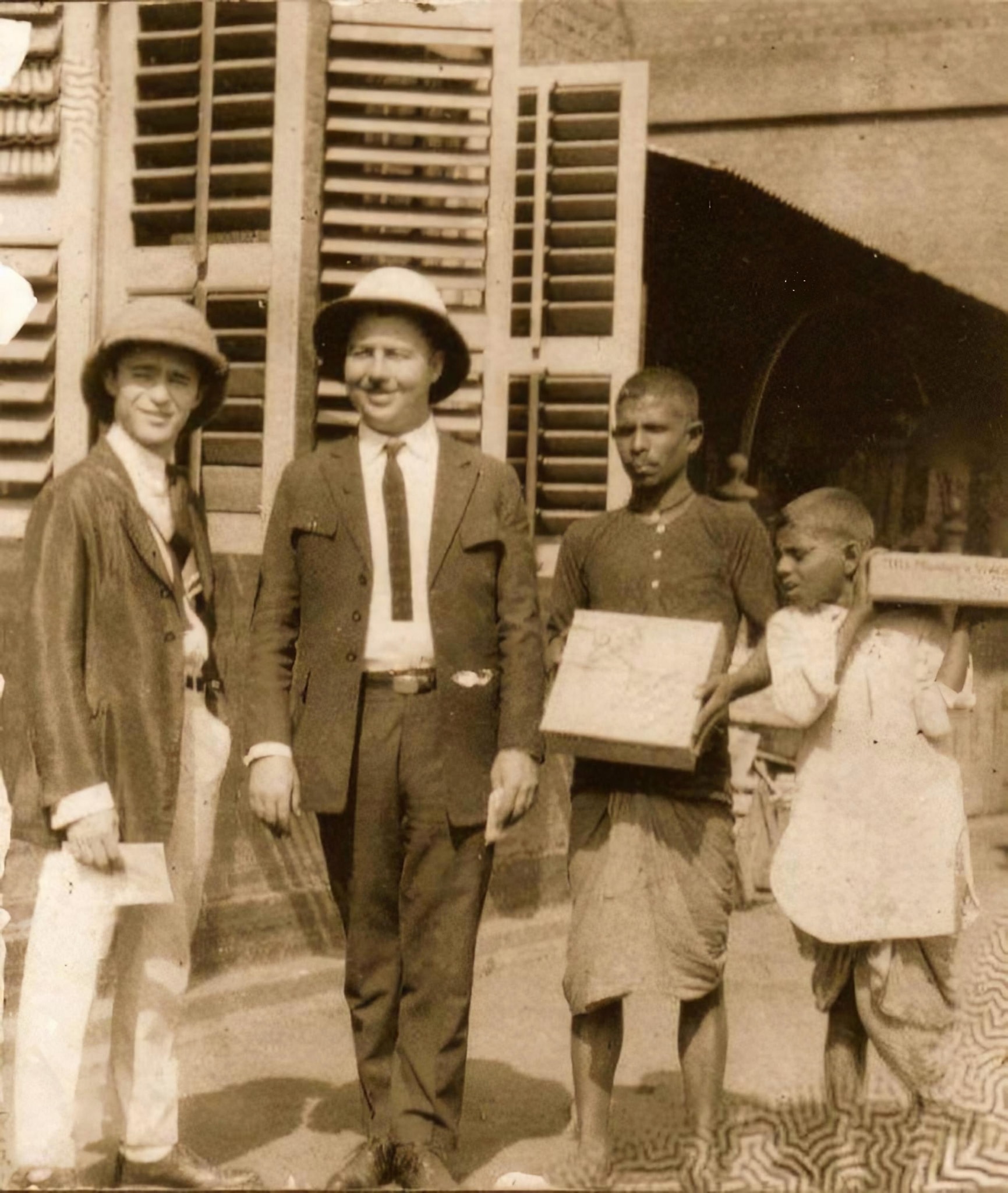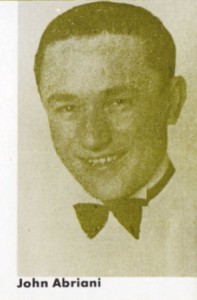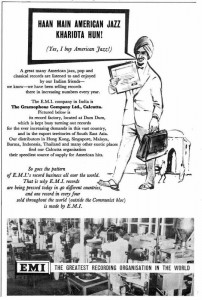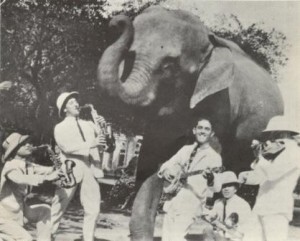Jazz, it’s clear, was the world’s first pop. The joyous form had the good fortune of being born right around the time that the gramophone was invented and global shipping was speeding up. In the first decade of the twentieth century, wax cylinders and shellac discs of Dixieland stomp made their way to the further corners of the planet faster than any other kind of music had done before. That’s proved conclusively by the image of this jazz band, shot in the Calcutta zoo in 1926: it’s led by a Canadian and his sidemen are from the Philippines, Austria, Mozambique, the US and Russia.

But the multinational origins of its members aren’t the only reason Lequime’s Grand Hotel Orchestra is significant. From a subcontinental point of view, they’re true pioneers. The year this photo was taken, trumpet player Jimmy Lequime and his band trooped into the HMV studios in Dum Dum to cut India’s first discs of “hot music”, as the genre was called before the word jazz became popular. The songs were titled Soho Blues and The House Where the Shutters Are Green.
Lequime had been hired to play at Calcutta’s luxurious Grand Hotel after burnishing his reputation in a nightclub in Shanghai called Mumm House. A wild port city with a taste for everything new (especially if it had a tinge of hedonism), Shanghai was already an important rendezvous for journeymen jazz musicians. Lequime’s band at Mumm House consisted of the trombone player Nick Ampier from the Philippines (a former US colony with a fondness for American pop culture), the Russian pianist Monia Liter (one of many conservatory-trained “White Russian” musicians who flooded through Asia after the 1917 revolution in their country), the American drummer Bill Houghton and his compatriot Pete Harmon. In addition to playing both alto and soprano sax, Pete Harmon was a sensation in Shanghai for his Al Jolson-style big, brash singing. When the Grand Hotel hired him to bring a big jazz outfit to Calcutta, Lequime supplemented his Shanghai band with Russian sax player Joe Speelman, American reedman Claude “Sax” MacGuire and Vic Halek, an Austrian who doubled up on violin and alto sax.

Jimmy Lequime (right) along with Joe Speelman pictured outside HMV’s Dum Dum studios in Calcutta with two local staff holding two boxes of freshly pressed copies of Soho Blues (1926). Photo Courtesy: Mark Berresford.
Upon their arrival in Calcutta, a young man named Al Bowlly offered his services as a vocalist and banjo player. Bowlly had been born to a Greek father and Lebanese mother in the country now known as Mozambique. He’d started his career in Johannesburg in the band of Edgar Adeler, an African of German descent and travelled with him to Singapore and Sourabaya, in the Dutch East Indies, as Indonesia was then known. But Adeler and Bowlly had a tremendous row, leaving the young musician stranded with his banjo case at the Sourbaya railway station. He eventually raised the money to sail to Calcutta, where he worked as a jockey.
At his audition for Lequime, Bowlly’s banjo playing was deemed adequate but his vocal style was considered pretty sissy and, evidently, afforded the rest of the band much amusement. So when they went into the record studio, Pete Harmon was the man at the mike. After his stint in India, Lequime headed east to Singapore for an engagement at Raffle’s Hotel. But Bowlly had bigger things on his mind and made his way to Europe.
 There, he would find himself playing under the leadership of the man who led the outfit that is thought to have been the second jazz band to record in India: John Abriani. The Abriani Six played at Calcutta’s Saturday Club from November 1932 until 1935 and is thought to have made a few recordings during the time. All these decades later, however, the sides the Six made for the Twin label in Calcutta seem to have disappeared from the archives and no collectors seem to have copies any more. Bowlly wasn’t on those recordings. He played with the Abriani Six in Berlin, but by the time the Italian led his band to India, Bowlly had moved on to England, where he eventually become the front man of the famous Ray Nobel Orchestra. (Earlier this year, Abriani was fictionalised as a character in this quirky, noir story by my friend Atul Sabharwal, writer and director of Powder, the best television serial ever to be made in India.)
There, he would find himself playing under the leadership of the man who led the outfit that is thought to have been the second jazz band to record in India: John Abriani. The Abriani Six played at Calcutta’s Saturday Club from November 1932 until 1935 and is thought to have made a few recordings during the time. All these decades later, however, the sides the Six made for the Twin label in Calcutta seem to have disappeared from the archives and no collectors seem to have copies any more. Bowlly wasn’t on those recordings. He played with the Abriani Six in Berlin, but by the time the Italian led his band to India, Bowlly had moved on to England, where he eventually become the front man of the famous Ray Nobel Orchestra. (Earlier this year, Abriani was fictionalised as a character in this quirky, noir story by my friend Atul Sabharwal, writer and director of Powder, the best television serial ever to be made in India.)
Bowlly was nothing if not prolific. He made more than 1,000 records between 1927 and 1941 and was considered Britain’s answer to the American Bing Crosby. Bowlly’s genius lay in how he used improvements in microphone design to fashion an intimate vocal style that would come to be called crooning. However, his career was cut short when he was killed by a German parachute mine in London during the Blitz. (In 1986, the British folk rocker Richard Thomson revived his memory with a tune called “Al Bowlly’s in Heaven”.) This video explains why Bowlly earned the nickname The Big Swoon.
By the time of Bowlly’s death, jazz had found firm roots in the subcontinent. It wasn’t only Westernised Indians in big cities like Bombay and Calcutta who developed a taste for the music. Swing bands soon appeared in cantonment towns and railway colonies too. Though foreign musicians were still travelling to Bombay and Calcutta, by the beginning of World War II, Indian jazz musicians formed the bulk of the bands. They played the music passionately but, tragically, few had the opportunity to record. Despite the boost the local Western music scene received during the war years because of the restrictions on the import of records, most of the sides that made their way to market were swing-tinged dance tunes. 
After the war ended, imports of American records started again and the HMV plant at Dum Dum continued to manufacture discs by the best US bands. But though it wasn’t listening to tunes by local bands, India’s appetite for jazz was so marked, it even became the subject of an international advertisement created by the EMI record company soon after the war (click on the image to see it larger).



10 comments
Thanks for the mention Naresh. Lovely piece. Abriani and his time in India should also get a standalone article on your site 🙂
Dear mr. Sabharwal,
I’m John Abriani’s nephew I’m very interested in your job about my grandfather and I would like more information if possible, thank you for all you can do.
best regards
riccardo fantin
Dear Mr. Ricardo,
I am glad that you liked the piece but I am sorry to disappoint you that I do not know much beyond what is already available on the internet about John Abriani and his travel to India mentioned on the sleeve of LP ‘Jazz And Hot Dance In India’
The title ‘Abriani’s Six’ became the inspiration for the story because Six bullets in a gun is a very common thread in Indian noir stories especially film noir and that was the theme of the magazine that printed the story.
The author of this blog Naresh Fernandes is the best person I know who can provide you with most insights on Jazz and Jazz musicians of that era.
Regards
Atul
http://www.facebook.com/l.php?u=http%3A%2F%2Fwww.youtube.com%2Fwatch%3Fv%3D8NDAWyH6Y8E%26feature%3Dyoutu.be&h=9AQFM6LEsAQGiJtbPsXs3kks6jLl2N0gpgsay0a3oJAftwQ
Hello
My father was Joe Speelman, the saxophonist in Jimmy Lequime’s band, it is amazing to have found this! He was also a cellist and have a recording of him playing that but had never heard him play the saxophone. Is is possible to get a recording of this or be able to download it as I would love to have it and indeed anything else that he was in that is available.
Best wishes
Tatiana
In your inbox, right now!
Best,
Naresh
Hi Tatiana
My father was Tom Clark (from Scotland) and was a friend of your father’s when he played at Raffles in Singapore. My father was an engineer working in Singapore and apparently Joe when back to Scotland on a family visit with my father to Glasgow at some point after the war.
I’ve looked through some old photos but can’t find any of your father at the moment – do you have any more info/photos of that period?
Thanks
Keith
Dear Tatiana,
My father who’s 92yo John Old (from Dundee, Scotland) an Engineer working in Malaya & Singapore …. was telling me the story of how he met your father and Dodo Mailinger in Singapore playing at the Raffles Hotel .. and in later years met him again playing in Malaya at the famous Le Coq D’or (which has since be pulled destroyed) …. Joe Speelman was playing the Violin in this Jazz band with Dodo Mailinger as the pianist. My parents used to go there between 1958 – 1965 for dancing …
Your father was more well known for his time when he was the Manager of the Selangor Club (now known as the Royal Selangor Club) ..
Hope this info is of some interest to you .. Lizzie Slothouber * Perth, West Australia *
I’ve been looking for the ‘Jazz And Hot Dance In India’ LP for over a year now, and they never come up.
Is it possible to get a good quality download from you?
Very interesting article about Al and the musicians he worked with in India. Here is a link to his recordings which start with the earliest ones in the 1920s.
https://www.albowlly.club/discography.html
There’s several recordings made with John Abriani too, starting from no 54 in the list. My fave is this one:
https://www.albowlly.club/78s/my-regular-girl-abriani.html